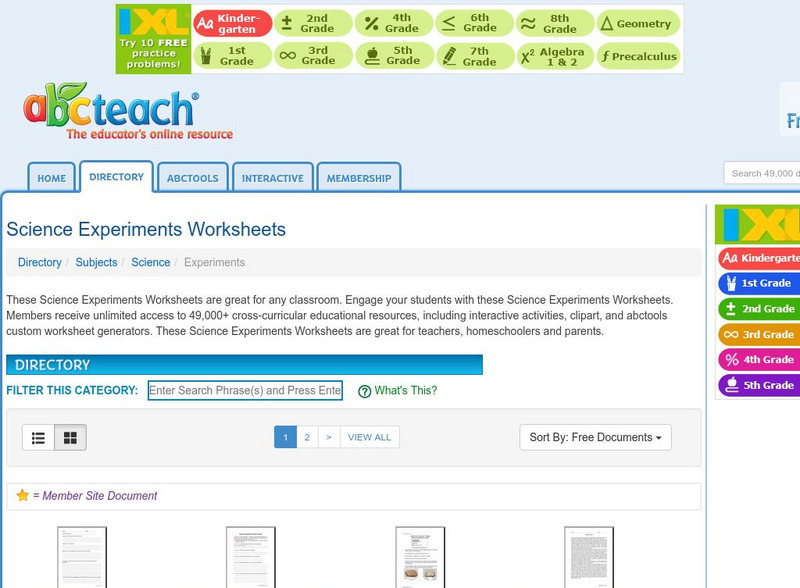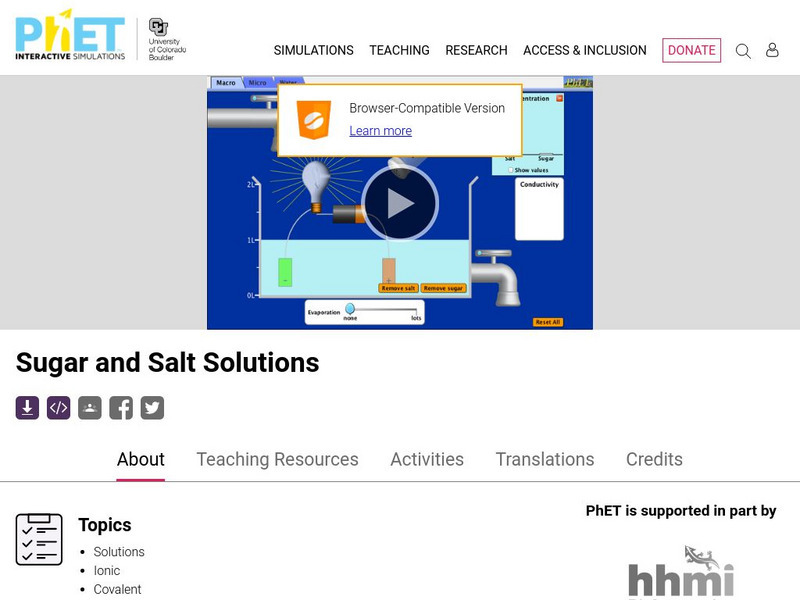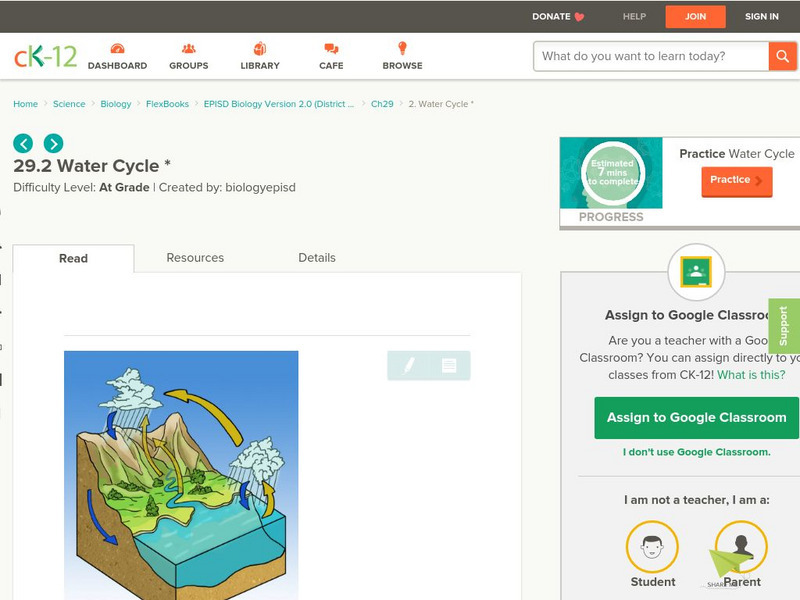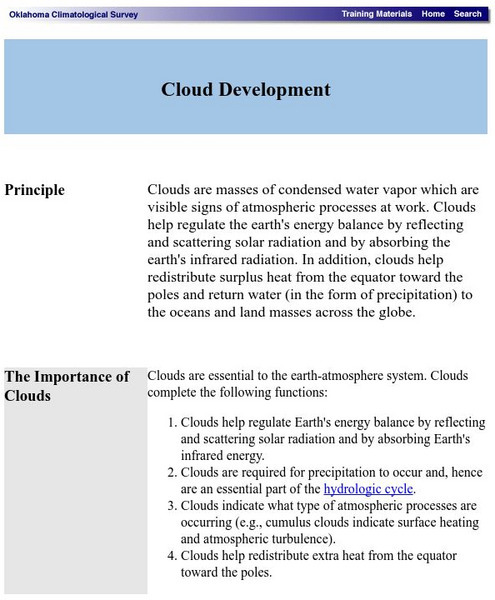National Health Museum
Access Excellence: Determining Transpiration From a Schoolyard Tree
A good project to link math skills with ecology. Hands-on activies help students understand the role of trees in ecosystems.
University Corporation for Atmospheric Research
Ucar: The Water Cycle
This site provides a comprehensive introduction to the water cycle. Students construct a model to simulate parts of the water cycle. Includes background information, links to standards, lesson plans, and assessment ideas.
PBS
Pbs Teachers:dimming the Sun
Conduct an experiment and investigate how air temperature, relative humidity, wind speed, solar radiation and precipitation affect evaporation. Graph the data collected during the experiment.
Science4Fun
Science4 Fun: Crystals
What are crystals? Discover how they are formed, what the evaporation and cooling crystallization process are, and the shapes of crystals.
Science and Mathematics Initiative for Learning Enhancement (SMILE)
Smile: Weather
This lesson plan focuses on teaching students to distinguish among the evaporation, condensation,and precipitation phases of the water cycle.
abcteach
Abcteach: Experiments
[Free Registration/Login Required] Elementary students learning to do experiments will be able to use these ready-made worksheets for gathering data on evaporation, melting ice and others.
Math Science Nucleus
Math/science Nucleus: Giving Water a Second Chance
This animation discusses water and the water cycle in a storybook format. Condensation, evaporation, and precipitation are all covered.
NOAA
Noaa: National Weather Service: Simplified Hydrologic Cycle
The National Weather Service offers information on the processes that make up the water (hydrologic) cycle, including evaporation and transpiration, precipitation, run-off, infiltration, and percolation. Has a good illustration and...
Center for Literacy and Disability Studies, University of North Carolina at Chapel Hill
Tar Heel Reader: The Water Cycle
Learn about the water cycle from this "book" that includes bright pictures and descriptions. Learn about precipitation, condensation, and evaporation and see examples of each phenomenon.
MadSci Network
Msn: How Does an Air Conditioner or Refrigerator Work?
From the Mad Scientist Network. Using a question and answer format, this page explains the answer to the question "How does An air conditioner or refrigerator work?" The scientific principles which underly their operation and the process...
Math Science Nucleus
Math/science Nucleus: Drippy Water Cycle Animation
This animation discusses the water cycle in a storybook format using the character Drippy. All the stages of the water cycle are covered.
Other
University of Alaska: Freezing of Hot and Cold Water
What will freeze first - hot water or cold water? Read this article and be surprised. This article provides great information about the freezing of water.
TeachEngineering
Teach Engineering: Dams
Through eight lessons, students are introduced to many facets of dams, including their basic components, the common types (all designed to resist strong forces), their primary benefits (electricity generation, water supply, flood...
University of Nebraska
University of Nebraska: Transpiration Water Movement Through Plants
This tutorial examines how water moves through a plant. Follow the pathway that water takes through plants from the roots to evaporation from cells in the leaves. Learn what controls rates of transpiration, how environmental conditions...
University of Colorado
University of Colorado: Ph Et Interactive Simulations: Sugar and Salt Solutions
What happens when sugar and salt are added to water? Pour in sugar, shake in salt, and evaporate water to see the effects on concentration and conductivity. Zoom in to see how different sugar and salt compounds dissolve. Zoom in again to...
Science Education Resource Center at Carleton College
Serc: Overnight Crystals to Illustrate Solubility Concepts
A lesson to study solubility by producing crystals by evaporating a salt solution. Lesson plan includes notes and a quiz.
Khan Academy
Khan Academy: Biology: Specific Heat, Heat of Vaporization, and Density of Water
Why does ice float? In this article answer that question by learning about the topics of Specific heat capacity, evaporative cooling, and heat of vaporization of water.
TeachEngineering
Teach Engineering: Ocean Water Desalination
Students learn about the techniques engineers have developed for changing ocean water into drinking water, including thermal and membrane desalination. They begin by reviewing the components of the natural water cycle. They see how...
CK-12 Foundation
Ck 12: Episd: Water Cycle
[Free Registration/Login may be required to access all resource tools.] An introduction to the biogeochemical cycle, the water cycle. Recognize evaporation, sublimation, and condensation. Identify groundwater and runoff water supplies.
BBC
Bbc Schools: Ks2 Bitesize: Science: Materials: Changes in Materials
Help solve the mystery and find the missing crystal. Following the activity, read more about chemical and physical changes, and then take a quick quiz to check for understanding.
University of Colorado
University of Colorado: Physics 2000: Bec: What Is It?
This is an understandable tutorial which guides the viewer through the innovations which led up to the verification of Bose-Einstein Condensation (BEC) in 1995. Follow the "Next," link at the bottom of the page to explore the following...
Science Buddies
Science Buddies: Weathering the Windchill: How Does Wind Speed Affect Objects?
With this science fair project measure the effect of wind speed on how quickly an object cools. The Science Buddies project ideas are set up consistently beginning with an abstract, objective, and introduction, followed by a section on...
Science Education Resource Center at Carleton College
Serc: Investigating Three Main Ingredients Needed to Create a Cloud in a Bottle
In the science lab, young scholars will create and observe the conditions necessary to make a cloud in a bottle.
Oklahoma Mesonet
Oklahoma Climatological Survey: Cloud Development
This site explores the importance of clouds and how clouds are formed. Content details common atmospheric cooling mechanisms and atmospheric stability.
Other popular searches
- Water Cycle and Evaporation
- Evaporation Experiment
- Evaporation and Condensation
- Condensation Evaporation
- Evaporation Kindergarten
- Heat and Evaporation
- Water Evaporation
- Melting and Evaporation
- Science Evaporation
- Filtration and Evaporation
- Condensation Evaporation Dew
- Evaporation and Temperature



















